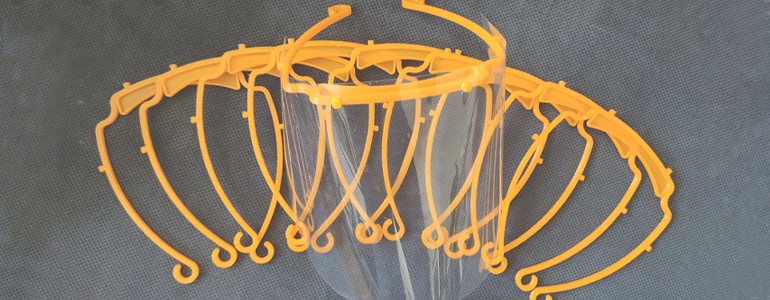
3D Printing Face Shields to Support Key Workers
Table of contents
Manufacturers across industry sectors are banding together to support key workers by producing ventilators, face shields and hand sanitizer. While 3D printing hobbyists and enthusiasts are organising mass, collaborative manufacture of face shields to meet the current, unprecedented demand.
What Are Face Shields and Why Are They So Important?
Face shields are clear, curved plastic visors held in place by adjustable headbands which provide up to 96% protection against the airborne transfer of bodily fluids.
Due to the massive increase in demand, various global collaborative efforts are ongoing in the push to produce and improve these shields and to extend the lifecycles of personal protective equipment.
Thankfully, face shields are relatively inexpensive to make and can even extend the useful life of protective face masks when used together. Among other benefits, research states that face shields reduce patient anxiety and the risk of self-inoculation – protecting patients and key workers alike.
How Can We Help?
If you have access to 3D printing at home, the first thing you can do is join a cause which supports your local demand.
Community organisers will point you toward the right face shield design to use – which filament or prototype you’ll produce will depend on the recipients’ preferences. Some recommend PETG (Glycol-modified Polyethylene Terephthalate) as it’s flexible and less conductive than other common 3D printing materials. But, whatever materials you’re using, it’s important to ensure stringent quality compliance throughout your community-run supply chain.
Once you’ve made the 3D printable parts, you can send them on for sterilisation, assembly and delivery.
What Are TECHNIA Doing?
In the past few weeks, members of the global TECHNIA team began running at-home production lines. Individual team members are running printers practically non-stop to produce up to 80 part sets per week. And now we’re using the 3DEXPERIENCE platform and SIMULIA to improve performance and turnaround.
Existing open source designs offer good protection and a flexible fit to reduce discomfort for users who may wear these shields for extended periods of time. Most of these designs also provide optimum printing parameters and solutions to common printing issues. But, we’ve identified an area for potential improvement.
By designing a peak to sit atop the headband, we should be able to provide even greater protection by narrowing the gap between the transparent shield and the face. TECHNIA team members are working to optimise this part to provide the required performance with the minimum amount of material and complexity, resulting in a shorter 3D printing cycle.
Share and inspire others with your stories of collaboration

